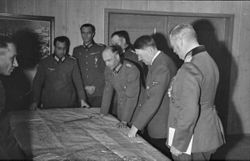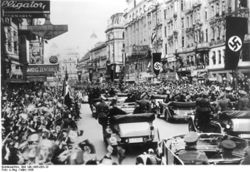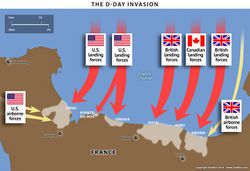How Was Hitler Responsible for the German Defeat in World War II
There were a plethora of factors that went into deciding the outcome of World War II. Political ideologies and national opinions were vastly different for the combatants, even amongst allied countries such as the United States and the Soviet Union. The industrial might of the United States was unmatched and Russia was the largest state in the world. Germany boasted brilliant generals and early in the conflict made great use of their innovative Lightning War, the Blitzkrieg.
Belligerents on each side had great strengths; however, it was the military leadership of Adolph Hitler that proved to be the greatest liability to Germany and ultimately cause its defeat. For Germany, the three greatest military mistakes made by Hitler concerned Dunkirk, Operation Barbarossa, and the Allied invasion of Normandy. The imprudent command decisions made by the Führer resulted in the Allied victory in Europe.
Prelude to War
Hitler came to power in January 1933. Two months hence, on March 23, the Enabling Act was passed through the Reichstag. This legislation essentially voided the Weimar Constitution and created a legal dictatorship, under which Hitler no longer needed approval from the Reichstag to enact any new laws. Further, on July 14, he declared that the National Socialist Party was the only legitimately recognized party in the nation. Through a tremendous propaganda campaign, he appeared as Germany’s Messiah and established a massive following. As his popularity grew, he deemed the time appropriate for Germany to annex European lands that housed ethnically German people.[1]
He first targeted Austria. Through a series of threats on Austrian Chancellor Kurt Schluschnigg and terrorist activities by the SA, the Anschluss was completed on March 12, 1938 and Austria was officially annexed by Germany. Next on Hitler’s agenda was the Sudetenland along the Czechoslovakian border. Germany’s land grabs did not go unnoticed by formidable European powers. British Prime Minister Neville Chamberlain organized a conference in Munich that included representatives from France, Germany, and Italy. Employing a policy of appeasement, Chamberlain agreed not to interfere with Germany’s annexation of the Sudetenland if in turn, Hitler guaranteed that there would be no war. The Munich Pact was signed on September 29, 1938, after which time Chamberlain returned to England with the announcement, “There will be peace in our time.” With that piece of business complete, Hitler then turned his aims toward Poland.[2]
The German-Soviet Non-Aggression Pact, the Molotov-Ribbentrop Pact, was signed August 23, 1939. This agreement was a guarantee by both nations that neither would turn hostile toward the other. The “secret clause” that was incorporated into the agreement stated that Poland was to be split between the two conquering countries.[3]This strategically brilliant move by Hitler guaranteed that Germany could invade Poland without interference from the Soviet Union and, perhaps more importantly, assured Hitler that once he waged his campaign to the west, he would not have to be concerned with a two-front war. With the efficiency of the Blitzkrieg, Germany invaded Poland on September 1, 1939. Per the Non-Aggression Pact, the eastern portion of the conquered nation belonged to the Soviet Union. With the threat of an attack by Stalin eliminated, Hitler turned west.
Hitler Turns West
After the invasion of Poland, both Britain and France declared war on Germany. The French military had constructed a defensive barrier during the interwar years known as the Maginot Line; so named after the French Minister of War, Andre Maginot. This line consisted of steel and concrete forts that housed large guns, casements and pill boxes for smaller guns, and an underground network of tunnels and facilities. The line, however, was greatly flawed. Although the southern end terminated at the Swiss border, the line continued north only to the point where France, Luxembourg, and Belgium converged. Enemy penetration of the line was possible through the gap to the north.
On May 10, 1940 the German invasion of France began. After penetrating Belgium, the German Army forged its way through the Ardennes. The Allies became trapped between the German tanks of Heinz Guderian and infantry troops of Fedor von Bock. On May 23, as they retreated into western Belgium and became encircled, British commander General Lord Gort ordered his troops to fall back toward the English Channel and began rescue operations from the beaches of Dunkirk. Meanwhile, Guderian’s armor had reached the coast and turned north toward Dunkirk. On May 24, with the full support of Adolph Hitler, General Gerard von Rundstedt ordered Guderian to halt his forces just fifteen miles away from Dunkirk. Compounding this tactically atrocious decision, Hitler and von Rundstedt ordered Bock’s infantry, rather than the tanks of Guderian, to capture the troops on the beaches.[4]
By opting for this slower-moving tactic, the Allies were afforded the precious gift of time and were able to begin evacuation maneuvers. With the aid of ordinary British citizens from all walks of life and in all types of water crafts, between May 27 and June 4, 1940, 338,000 Allied soldiers managed to escape Dunkirk, 224,000 of which were British.[5]This was a tremendous morale boost for Allied soldiers and citizens alike. Additionally, the men who escaped were reincorporated into the British fighting forces. If Hitler had pursued his attack and decimated the troops at Dunkirk, he may have been able to force Churchill into peace negotiations in the early summer of 1940 while the Non-Aggression Pact was still in effect; at the same time that Paris fell to Germany, and before the U.S. entered the war. He instead fought an air war (The Battle of Britain) over England from July through October 1940 and the following year turned his attentions toward the east.
Operation Barbarossa
June 22, 1941 marked the beginning of Operation Barbarossa. For this intricate attack, German troops were split into three divisions: Army Group North, under von Leeb; Army Group South, commanded by von Rundstedt; and Army Group Center, led by von Bock. Army Group North was destined for Leningrad, the troops under von Rundstedt in the south were to proceed through Ukraine to secure the plentiful natural resources of that country, and von Bock’s men in the Center Group were ordered through the Soviet portion of Poland to Belorussia and on to Moscow.[6]
The initial advance was awesome in scope and execution; the German Army covered in excess of two hundred miles in one week. As of August 5, Army Group Center was two-thirds of the way to Moscow. The advance was halted; however, on August 20, when Hitler made another, and perhaps his most fatal, tactical mistake. He ordered the diversion of armor from the Center Group to the groups in the north and south. By doing so, he left the Center Group with only infantry divisions. This delay in attacking Moscow afforded Stalin the time necessary to move his industrial facilities out of Moscow to the east. When the redeployment of armor was complete, the German Army began its siege of Leningrad.[7]
The battle for Leningrad began on September 8, 1941. The Germans dismantled the Russian railroad, which cut supplies to the city. Hitler’s plan was to starve Leningrad into submission. More than 200,000 Russians died of starvation or starvation related diseases. The valiant efforts of the citizens of Leningrad, who fought with any weapon they were able to fashion (even going so far as to throw pans of boiling water into the faces of German soldiers), allowed the Russian industrial plants the opportunity to produce armaments and supplies.[8]
At the end of September, German armor was deployed back to the Center Group and the advance on Moscow was renewed. The delay in attacking the city afforded Russian General Zhukov ample time to dispatch his reserve troops. By the end of November, the Russian soldiers under Zhukov’s command were successful in out-flanking German Army Group Center. Seeing that he was trapped and aware that the German soldiers were grossly ill-equipped to survive a Russian winter, von Bock requested permission from Hitler to retreat. His request was denied by the infuriated Hitler, who forbade retreat by any of his troops. Due to yet another tactical mistake made by the Führer, the Eastern Front was in a stalemate by March 1942.[9]

Hitler’s command of this attempted Blitzkrieg was an utter failure. By early spring 1942, his armies were fighting in Russia, Africa, and Italy, in addition to occupying France. Further, Germany was in a precarious geographic position from the outset of the war. This, combined with Hitler’s ineptitude as a military commander, were the primary reasons Germany was defeated in the Second World War.
Stalingrad
His incompetence as a military leader was again proven when he ordered the siege of Stalingrad. The city had no real logistical significance to Germany, rather, Hitler wanted to capture the city that bore Stalin’s name as an expression of German dominance over the Soviet Union. This symbolic mission began on November 23, 1942; more than eleven months after the U.S. had entered the war on the side of the Allies. Roosevelt’s men were bolstering Allied troop numbers, and more importantly the U.S. was supplying great amounts of food, equipment, and munitions to the Allied war effort. Additionally, the Soviet industrial plants were producing tremendous amounts of the same and due to a massive conscription effort after the invasion of the previous year, the Soviet Army was now stronger and fresher.
The battle was a hard fought, street-to-street, even room-to-room, conflict. Soviet snipers utilized the city’s sewers and demolished buildings to inflict a great number of casualties on the German troops. The German 6th Army, under the command of General Paulus, was encircled by the Soviet Army. Like von Bock, Paulus requested permission to abandon the city in order to save his fighting force. Again, Hitler refused the request and informed his generals that retreat or surrender was not an option. The Luftwaffe tried unsuccessfully to supply Paulus and his men. Medical supplies and food had been exhausted by the 6th Army and General Paulus resorted to taking food from the injured soldiers to feed his healthy troops.[10]
On December 12, Field Marshall Manstein attempted to make contact with Paulus’s garrison inside Stalingrad, yet was unable to do so unless the 6th Army was allowed to evacuate the city. Meanwhile, the Soviets launched another offensive north of the city where the Italian 8th Army was positioned in support of its German allies. The Soviets broke through the Italian line and proceeded south in an attempt to completely surround Paulus. At this point, the German 6th Army was completely isolated in the city and on February 2, 1943, Paulus surrendered. In the battle, the German Army lost 200,000 troops; 90,000 of which were taken prisoner.[11] Had Hitler allowed Paulus to withdraw from Stalingrad, the 6th Army would have been able to join with Manstein’s troops. They would have been able to reorganize, obtain food and munitions, and have retained a great number of soldiers. By forcing Paulus to remain surrounded in the city, Hitler caused the loss of manpower and a skilled leader.
D-Day
Germany’s final grave error came on June 6, 1944 during the Allied invasion of Normandy; Operation Overlord. Hitler was actually correct in believing the Allied invasion was to come at Normandy, whereas von Rundstedt and Rommel, among others, had been deceived into believing that the invasion across the English Channel would come at the port city of Calais. General George Patton’s 3rd Army was positioned in southern England, which was a strategically logical point from which to launch the invasion at Calais. Further, the Allied commanders issued false intelligence reports that they knew would be intercepted by the German spy network. Finally, Normandy was not a port city and therefore seemed unlikely as an invasion site. This choice created a great amount of additional work and challenges for the Allies; however, the deception was successful.[12]
Once the invasions forces left England, Hitler altered his opinion and agreed with von Rundstedt that the invasion would come at Calais. While Rommel saw that the forces were targeting Normandy, Hitler believed it was a ruse due to the relatively small number of troops initially deployed by the Allies. With paratroopers from the 101st and 82nd Airborne Divisions dropping behind German lines, the invasion was underway and General Rommel strongly urged Hitler and von Rundstedt to deploy all of the German forces possible to Normandy. Hitler refused and retired to his bed on the night of June 5, 1944.
Upon further consideration, von Rundstedt agreed with Rommel yet refused to act without the Führer’s permission. Hitler was sleeping at the time of the D-Day invasion and not one of his subordinates would act autonomously nor wake him. As a result, the German Army did not deploy men and equipment for twelve hours after the invasion began. They did have sixty divisions positioned at Normandy; however, thirty of these divisions were reserve troops with no combat experience.[13]
As a result of Hitler’s inability to wage a successful military campaign, the Allies were able to land 150,000 troops in just one day. With the success of Operation Overlord, the Allied troops created a formidable second front with which the Germans had to contend, thereby facilitating the Soviet Army in its advance to the west. When the invasion was completed, 2,876,000 men, 11,000 aircraft, and 5,000 ships had been utilized by the Allied forces. By June 13, the Allies held sixty miles of beach. The port city of Cherbourg was secured on June 27, the rail junction of St. Lo was held on July 8, Caen was taken on July 18, and on August 26, Paris was at last liberated. The Allied success at Normandy was due to the refusal of Hitler to heed the advice of perhaps his greatest general.[14]
Conclusion
Adolph Hitler committed suicide on April 30, 1945. On May 8, Germany officially surrendered. Germany’s position near the center of the European continent, as opposed to the U.S., Canada, and Britain who were isolated by water, played a significant part in the following statistics:
Number of Dead by Country in World War II:[15][16]
- Russia-22 Million
- Germany- 6 Million
- France- 500,000
- Britain- 390,000
- United States- 170,000
- Canada- 40,000
The above numbers do not include the victims of the Holocaust.
Hitler’s first big mistake came at Dunkirk. This was followed by his decision to divert armor during Operation Barbarossa, his failure to allow Paulus to withdraw from Stalingrad, and his refusal to heed the advice of General Rommel during the D-Day invasion. Had these decisions been left solely to experienced military strategists, the war may have proceeded in quite a different manner. Other factors of total war, such as industrial might, women in the workforce, and economics also played an important role in the outcome of the war. Ultimately, however, the Allies were victorious in Europe due to the Atlantic Ocean, English Channel, and the gross ineptitude of Adolph Hitler.
References
- ↑ Stephen Toth, “Total War and Crisis” (lecture, Arizona State University, Glendale, October 20, 2011).
- ↑ Toth, October 25, 2011.
- ↑ Michael J. Lyons, World War II: A Short History, 5th ed. (Upper Saddle River, NJ: Prentice Hall, 2010), 57-58.
- ↑ Lyons, 80. For an in depth study of the importance of Dunkirk, see Norman Gelb, Dunkirk: The Complete Story of the First Step in the Defeat of Hitler (New York: Morrow, 1989).
- ↑ Lyons, 81.
- ↑ Lyons, 107. For two excellent, in-depth accounts of the invasion, see John Erickson and David Dilks, eds., Barbarossa: The Axis and the Allies (Edinburgh: Edinburgh University Press, 1994) and David Glanz, Barbarossa: Hitler’s Invasion of Russia, 1941 (Charleston, SC: Tempus, 2004).
- ↑ Lyons, 109.
- ↑ Toth, November 3, 2011.
- ↑ Lyons, 112-13.
- ↑ Lyons, 178-79.
- ↑ Lyons, 179.
- ↑ Lyons, 248-49.
- ↑ Lyons, 249-50.
- ↑ Toth, November 17, 2011.
- ↑ Toth, December 1, 2011.
- ↑ Lyons, 295.
Admin, Costello65 and EricLambrecht





